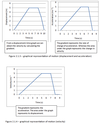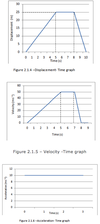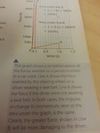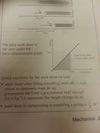Chap. 2, Mechanics Flashcards
(33 cards)
2.1.1 Define displacement, velocity, speed and acceleration.
Displacement
- Displacement is the distance moved in a particular direction.
- Vector quantity.
- SI unit: m
- Symbol: s
Velocity
- Velocity is the rate of change of displacement.
- Vector quantity.
- Velocity = (change in displacement / change in time)
- SI unit: m s-1
- Symbol:** v **or u
Speed
- Speed is the rate of change of distance.
- Scalar quantity.
- Speed = (change in distance / change in time)
- SI unit: m s-1
- Symbol: v or u
Note that speed and velocity are not the same thing. Velocity has a direction.
Acceleration
- Acceleration is the rate of change of velocity.
- Vector quantity.
- Acceleration = (change in velocity / change in time)
- SI unit: m s-2
- Symbol: a
Note that acceleration is any change in velocity, meaning an increase or decrease in velocity or a change in direction.
2.1.2 Explain the difference between instantaneous and average values of speed, velocity and acceleration.
Instantaneous
An instantaneous value of speed, velocity or acceleration is one that is at a particular point in time. For example, the speed of a car at a particular instance.
Average
An average value of speed, velocity or acceleration is one that is taken over a period of time. For example, the avarage speed of a car, found by taken the total distance divided by the total time.
2.1.3 Outline the conditions under which the equations for uniformly accelerated motion may be applied.
The equations of uniformly accelerated motion can only be under conditions where the acceleration is constant.
The equations of uniformly accelerated motion are as follows in the picture:

2.1.4 Identify the acceleration of a body falling in a vacuum near the Earth’s surface with the acceleration g of free fall.
When we ignore the effect of air resistance on an object falling down to earth due to gravity we say the object is in free fall. Free fall is an example of uniformly accelerated motion as the only force acting on the object is that of gravity.
On the earths surface, the acceleration of an object in free fall is about 9.81 ms-1. We use the letter g to denote this acceleration. Since the accelertaion is constant, we can use the suvat equations to solve the problem
2.1.5 Solve problems involving the equations of uniformly accelerated motion.
A car accelerates with uniformly from rest. After 10s it has travelled 200 m.
Calculate:
Its average acceleration
S = ut + 1/2 at²
200 = 0 x 10 + 1/2 x a x 10²
200 = 50a
a = 4 m s-2
Its instantaneous speed after 10s
v² = u ² + 2as
= 0 + 2 x 4 x 10
= 80
V= 8.9 m s-1
2.1.6 Describe the effects of air resistance on falling objects.
Air resistance eventually affects all objects that are in motion. Due to the effect of air resistance objects can reach terminal velocity. This is a point by which the velocity remains constant and acceleration is zero.
In the absence of air resistance all objects have the same acceleration irrespective of its mass.

2.1.7 Draw and analyse distance-time graphs, displacement-time graphs, velocity-time graphs and acceleration-time graphs.
Gradient = change in y / change in x

2.2.9 Solve problems involving Newton’s second law.
2.1.8 Calculate and interpret the gradients of displacement–time graphs and velocity–time graphs, and the areas under velocity–time graphs and acceleration–time graphs.
Calculations on displacement–time graph (see picture)
Determining its velocity
We know that the gradient of a displacement – time graph gives us its velocity. Therefore for the first 5 seconds the speed is:
25/5 =5ms-¹
After the first 5 s the object is stationary for 3 s. For these 3s its velocity is zero.
After 8s the object starts to return at a faster speed then before. From the graph we find the speed to be:
25/2 =12.5ms-¹
Calculations on velocity–time graph (see picture)
Determine its acceleration
We know that the gradient of a velocity- Time graph gives us its acceleration. Therefore for the first 5 s the acceleration is:
50/5 =10 ms-²
When the object is at constant speed from 5s to 7s its acceleration is zero. During the last second of the objects journey the object is decelerating at:
50/1 =50 ms-²
Determine its displacement
The area under a velocity-time graph is the displacement. During the first 5 s the object has travelled:
½ x 5 x 50 = 125m
Calculations on acceleration–time graph (see picture)
Determine the change in velocity
The area under the acceleration- Time graph gives us the change in velocity
From the graph we find that the change in velocity is 10 x 3 = 30 ms-¹
Note: The gradient of the acceleration - time graph is actually the rate of change of acceleration. However it isn’t often useful.

2.1.9 Determine relative velocity in one and in two dimensions.
- One dimension have only two possible directions backwards or forwardds [so negative and positive signs are enough].
- Two dimension frames have an entire plane with infinite choices for relative movement so direction vectors have to be considered.
2.2.1 Calculate the weight of a body using the expression W = mg.
In general terms one can describe any force as ‘the cause of a deformation or a velocity change’. A force is a vector quantity and the SI units for the measurement of force are Newton’s (N).
Weight
The weight of a body is the gravitational force experienced by that body. On earth the formula give is:
W = mg
m - The mass of the body measured in kilograms (kg)
g - the gravitational field strength of the earth which is measured in Newton’s per kilogram (N kg-1) or sometimes m s-2. On the surface of the earth g= 9.81 N kg-1.
2.2.2 Identify the forces acting on an object and draw free-body diagrams representing the forces acting.
Each force should be labelled by name or given a commonly accepted symbol. Vectors should have lengths approximately proportional to their magnitudes.
Tension
A string that is taut is said to be under tension. Therefore we can say tension is the force that arises in any body when it is stretched. (Note that a string or rope that is not taut has zero tension in it).
Normal Reaction force:
If a body touches another body, there is a reaction force between the two bodies. This force is perpendicular to the body exerting the force:
Drag Force:
Drag forces are forces that oppose the motion of a body through a fluid (gas or liquid). They are directed opposite to the velocity of the body and generally depend on the speed of that body. Higher speed equals higher drag force.
Up thrust:
An object placed in a fluid medium will experience up thrust. If the up thrust force on a body is equal to the weight, the body will float in the fluid.
Frictional Forces:
Frictional forces are forces that oppose the motion of a body
Hooke’s Law:
Hooke’s law states that up to the elastic limit, the extension, x of a spring is proportional to the tension force, F. The constant of proportionality k is called the spring constant. SI units of spring constant are N m-1.
Mathematically,
F∞x
F = Kx

- 2.3 Determine the resultant force in different situations.
- 2.6 State the condition for translational equilibrium.
- 2.7 Solve problems involving translational equilibrium.
Resultant force / net force: the overall force acting on an object when all the individual forces acting on that object have been added together.
Transitional equilibrium / balanced force: the resultant force on an object in zero in all directions because they cancel each other out. This means that the body is not accelerating.
Formula needed: F=ma
In order to sold solve problems involving translational equilibrium, you need to find the resultant force on an object and determine whether it is 0 or not. If it is 0, then the object is not accelerating and is in translational equilibrium.

- 2.4 State Newton’s first law of motion.
- 2.5 Describe examples of Newton’s first law.
Newton’s first law of motion: A body will remain at rest or moving at constant velocity unless acted upon by an unbalanced force.
1N = 1kgms-2
Example:
- Common sense that something does not start to move unless there is a resultant force acting on it.
- A body can be in equilibrium, even through it is moving.
- A body can move without the force being exerted, even though this goes against both common sense.

- 2.8 State Newton’s second law of motion.
- 2.9 Solve problems involving Newton’s second law.
F = ma
The rate of change of momentum of an object is proportional to the applied force and takes place in the direction in which the force acts.
The acceleration of a body is proportional to the force applide and inversly porpotional to its mass.
- F: force or unbalanced force in N
- m: mass measured in kg
- a: the acceleration in ms-2

- 2.10 Define linear momentum and impulse.
- 2.13 Solve problems involving momentum and impulse.
Momentum is a vector quantity, meaning it has direction and magnitude.
** Linear momentum:**
This is a property that depends on the velocity and mass on a body. It is defined as the product of mass and velocity.
- Momentum = mass x velocity*
- p=mv*
P = momentum kg ms-1
m = mass kg
v = velocity ms-1
Given that mass usually remains constant, this is often written: p=mΔv
Impulse:
The change in momentum of a body is also known as the inmpulse. It is defined as the product of a force and the time during which it acts.
Impulse = FΔt = mΔv
The unit for impulse is Ns and this can also be used as a unit of momentum.
In words we say that impulse is the change in momentum while force is the rate of change of momentum.
FΔt = Δp = mΔv
F= (final momentum - initial momentum) / time taken = Δp/Δt
2.2.11 Determine the impulse due to a time-varying force by interpreting a force’s time graph.
The impulse of a time-varying force is represented by the net area under the function of the force-time graph.

2.2.12 State the law of conservation of linear momentum.
The law of conservation of linear momentum states that ‘the total linear momentum of a system of interacting particles remains constant provided there is no resultant external force, (or when the net external force is equivalent to zero) ‘
2.2.14 State Newton’s third law of motion.
Newton’s third law states that if body A exerts a force on body B, then body B, exerts an equal and opposite force on body A.
FAB =- FBA
2.2.15 Discuss examples of Newton’s third law.
- Two ice skaters push off of each other. They both exert equal and opposite forces, and slide backwards.
- A racket exerts a force on the racket ball, and the ball exerts an equal and opposite force on the racket
- The earth exerts a force on the moon (keeps it in orbit) and the moon exerts an equal and opposite force on the earth (influences the tides in the ocean)
2.3.1. Outline what is meant by work.
- Work is defined as the force times the displacement moved in the direction of the force.
- If there is no movment in the direction of the force, then you have not done work. For example, if your car is stuck in mud, you may exert force on it by pushing it, but unless you move it, no work will be done
- It is a scalar quanitity
W = Fscosθ
W is the work measured in J
F is the force measured in N
s is the distance moved measured in m
θ is the angle between the applied force and the direction of motion
To convert it into a SI unit ==> 1J = 1N m
If the force and the displacement are in the same direction, this can be simplified to
Work done = force x distance
Energy and work
Energy and work are linked together. When you do work on an object it gains energy and you lose energy. The amont of energy transferred is equal to the workd done. Energy is a measure of the amount of work done. This mean that the units of energy must be the same for the units of work. - jouls.
2.3.2. Determine the work done by a non-constant force by interpreting a force-displacement graph.
The work done by a non-constant force is represented by the net area under the function of the force-displacement graph

- 3.3 Solve problems involoving the work done by force
* A force of 40N acting 60o to the horizontal pulls a block of mass 10kg a distance of 2.0m across a smooth surface. How much work is done?*


2.3.4. Outline what is meant by kinetic energy.
- *Energy:** is the ability to do work.
- *Kinetic energy (Ek):** is the energy an object possesses due to motion. The word kinetic refers to motion.
Ek =1/2mv2






